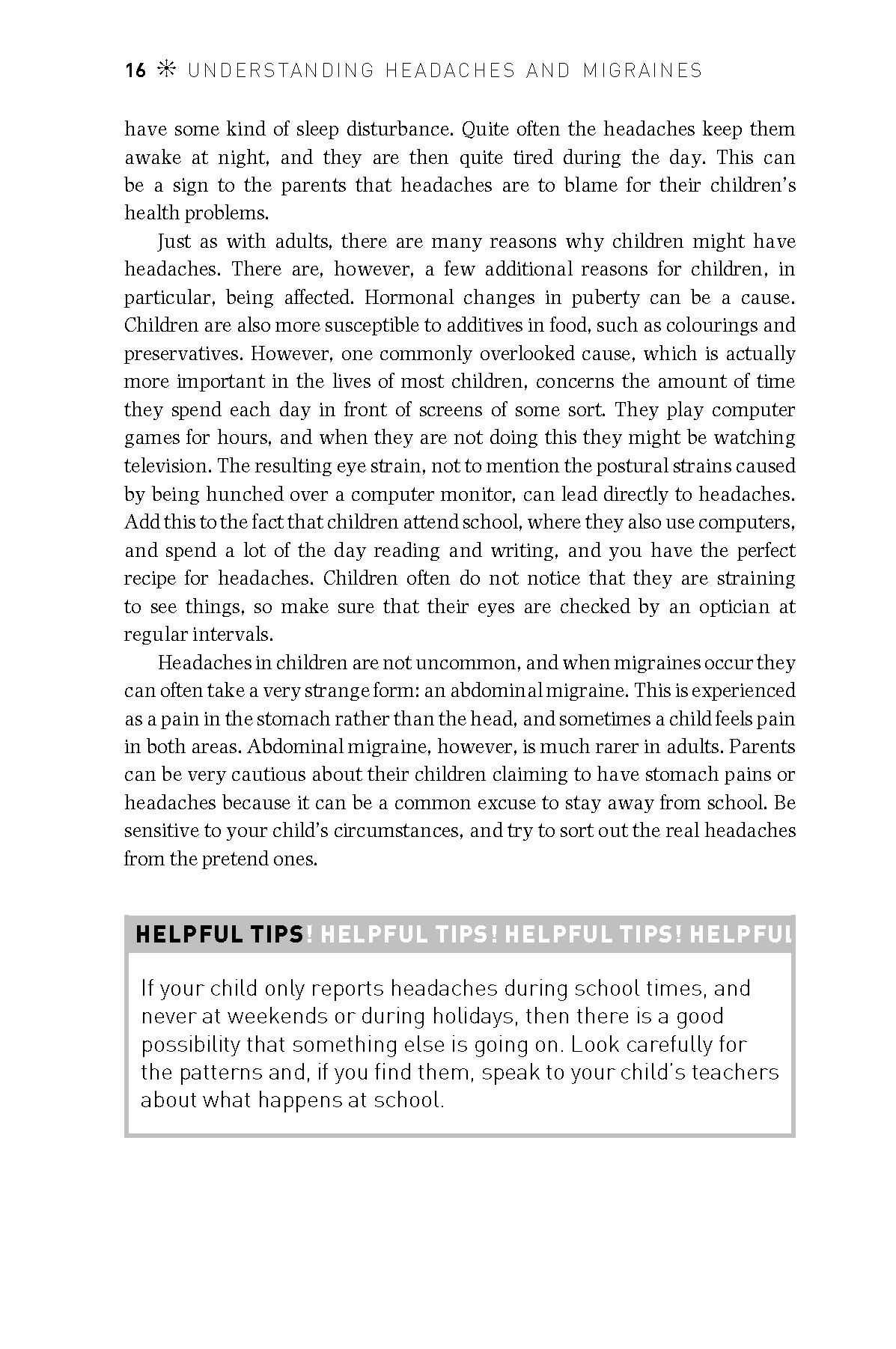UHAM033

16 * UNDERSTANDING HEADACHES AND M IG RAI N ES have some kind of sleep disturbance. Quite often the headaches keep them awake at night, and they are then ąuite tired during the day. This can be a sign to the parents that headaches are to blame for their children’s health problems.
Just as with adults, there are many reasons why children might have headaches. There are, however, a few additional reasons for children, in particular, being affected. Hormonal changes in puberty can be a cause. Children are also morę susceptible to additives in food, such as colourings and preservatives. However, one commonly overlooked cause, which is actually morę important in the lives of most children, concerns the amount of time they spend each day in front of screens of some sort. They play Computer games for hours, and when they are not doing this they might be watching television. The resulting eye strain, not to mention the postural strains caused by being hunched over a Computer monitor, can lead directly to headaches. Add this to the fact that children attend school, where they also use computers, and spend a lot of the day reading and writing, and you have the perfect recipe for headaches. Children often do not notice that they are straining to see things, so make surę that their eyes are checked by an optician at regular intervals.
Headaches in children are not uncommon, and when migraines occur they can often take a very strangeform: an abdominalmigraine. This is experienced as a pain in the stornach rather than the head, and sometimes a child feels pain in both areas. Abdominal migraine, however, is much rarer in adults. Parents can be very cautious about their children claiming to have stornach pains or headaches because it can be a common excuse to stay away from school. Be sensitive to your child’s circumstances, and try to sort out the real headaches from the pretend ones.
HELPFUL TIPS
HELPFUL TIPS! HELPFUL TIPS! HELPFUL
If your child only reports headaches during school times, and never at weekends or during holidays, then there is a good possibility that something else is going on. Look carefully for the patterns and, if you find them, speak to your child’s teachers about what happensat school.
Wyszukiwarka
Podobne podstrony:
UHAM039 22 * UNDERSTANDING HEADACHES AND M IG RAI N ES African-Caribbean people or Asian people (in
UHAM035 18 * UNDERSTANDING HEADACHES AND M IG RAI N ES One particular problem in people in their lat
UHAM037 20 * UNDERSTANDING HEADACHES AND M IG RAI N ES episodes in Life and the onset of a headache.
UHAM030 WHO HAS HEADACHES AND M IG RAI N ES? * 13 headaches are also often commonly associated with
UHAM034 WHO HAS HEADACHES AND M IG RAI N ES? * 17 In children especially, migraines can be felt in t
UHAM036 WHO HAS HEADACHES AND M IG RAI N ES? * 19 what is wrong with the vehicle. So when you see yo
UHAM041 24 * UNDERSTANDING HEADACHES AND M IG RAI N ES is in intensity rather than quality. In all o
UHAM043 26 * UNDERSTANDING HEADACHES AND M IG RAI N ES A common migraine aura involves a scintiUati
UHAM045 28 * UNDERSTANDING HEADACHES AND M IG RAI N ES own migraine triggers, perhaps by maintaining
UHAM047 30 * UNDERSTANDING HEADACHES AND M IG RAI N ES it. Aft er a migraine attack, I can f ee L w
UHAM049 32 * UNDERSTANDING HEADACHES AND M IG RAI N ES get a full-blown attack. However, I do stillf
UHAM051 34 * UNDERSTANDING HEADACHES AND M IG RAI N ES can mean that I have to dnve everyone around
UHAM055 38 * UNDERSTANDING HEADACHES AND M IG RAI N ES Stress, food, drink and light are aLL common
UHAM057 40 * UNDERSTANDING HEADACHES AND M IG RAI N ES being served the wrong dish in a restaurant a
UHAM059 42 * UNDERSTANDING HEADACHES AND M IG RAI N ES placed on the muscles may leadto chronic head
UHAM061 44 * UNDERSTANDING HEADACHES AND M IG RAI N ES mercury is emitted, which can be breathed in.
więcej podobnych podstron